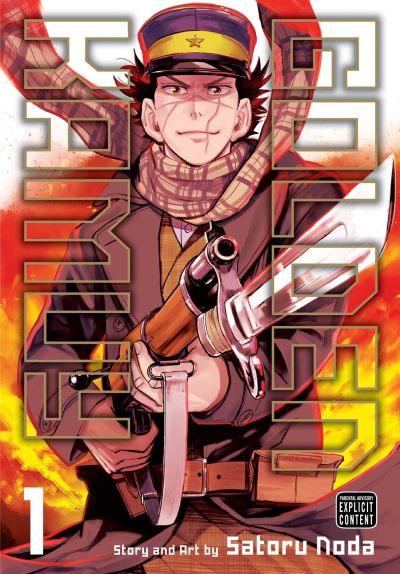Easy Money
Golden Kamuy, volume 1
By Satoru Noda

12 Aug, 2020
Satoru Noda’s Golden Kamuy (ゴールデンカムイ, Gōruden Kamui) is an ongoing Japanese manga; it has been serialized in Shueisha’s Weekly Young Jump magazine since 2014. Thus far, there have been twenty-two tankōbon volumes. Volume 1 covers the first seven issues.
Thousands of Japanese soldiers died assaulting 203 Metre Hill during the Russo-Japanese War. Not Saichi “Immortal” Sugimoto, who earned his nickname shrugging off what should have been mortal injuries while carving his way through (very briefly) terrified Russian troops.
The Japanese government rewarded Saichi’s valour by discharging him without a pension. Penniless, and desperate for money, the young soldier tries his hand at gold prospecting in Hokkaido. Gold ore eludes him, until a chance encounter with a prospector offers him a quick pass to easy street.
The prospector relates the tale of how, years before, Ainu eager for an independent homeland of their own amassed a considerable amount of gold — seventy-five kilograms, according to legend. Before they could use it to fund an independence movement, the Ainu in charge of the gold were all murdered and the gold vanished. The killer was soon caught but to this day, he refuses to say what he did with the gold. But he did leave some clues …
While still imprisoned in Abashiri Prison, the killer chose twenty-four gullible inmates. Each inmate was tattooed with a portion of the treasure map. All escaped the prison. If they were to assemble, they would be able to find the gold! Except for some reason they do not appear to have collected the gold.
It’s a wild tale but when the prospector sobers up, he tries to murder Saichi. The drunkard is one of the escapees, and the gold is very much real. The catch that has so far forestalled gold recovery is a nasty trick the murderer in Abashiri played on his victims: the easiest way to read the maps is by murdering each prisoner, flaying them, and stitching their tanned skins into a single document. As soon as they realized just what had been done to them, those prisoners who survived the first round of murders dispersed. A game of cat and mouse ensued, complicated when a rogue army unit joined the game. Now Saichi has become another competitor in the search.
In short order, Saichi teams up with a young Ainu girl named Asirpa, whose natural skepticism about the wild tale is overcome by her knowledge that the gold does indeed exist: her father was one of the Ainu murdered for the gold. Her quick wits and wilderness skills make her an invaluable ally in the deadly game of hide and seek. There’s a complication: Saichi abhors murder.
~oOo~
Warning: the manga is set in a rural region, a century ago. The animals who appear in the manga are, with one notable exception (Asirpa’s wolf), either predators who will eat humans or prey for humans1 and other animals. Cute squirrels? Food. Unwary prospectors who should be a lot more aware of the local bear population than they are? Food. Adorable bear cubs? Food. Cuteness is no protection.
Saichi isn’t greedy for purely personal reasons. He is in love with his best friend’s widow, who needs an expensive operation to save her eyesight. He isn’t a sadistic monster either, unlike some of his rivals for the gold. It’s just that he’s highly motivated and has a pragmatic worldview shaped by his horrific experiences in the Russo-Japanese War. Some of his rivals, on the other hand, arecomplete monsters. Where Saichi will reluctantly kill in self-defence, the people with whom he must contend will murder without any hesitation.
The author tries hard for verisimilitude. The tale of lost treasure is implausible, but the setting, Hokkaido in the early 20th century, is as plausible as he can make it. To quote Wikipedia, “the Ainu language in the story is supervised by Hiroshi Nakagawa, an Ainu language linguist from Chiba University.” While it is true that one character, Asirpa, doesn’t conform to Ainu gender roles of the period, there is an in-story explanation for this. Two, in fact: the explanation Asirpa believes to be true and the one revealed many many volumes down the road. Yes, I read ahead.
The art is skillfully done, which is not always an asset when what is being depicted is someone’s head being blown up or some hapless soldier being eviscerated. The tone of the manga is variable, veering from comedy to horrific violence. The mystery of the missing gold is a great plot hook, but given that the series is already twenty-two volumes, I’m wondering if the gold will ever be found.
Recommended if this is the sort of thing you like.
Golden Kamuy is available here (Amazon US), here (Amazon Canada), here (Amazon UK), here (Barnes & Noble), here (Book Depository), and here (Chapters-Indigo).
1: See also Ryōko Kui’s Danjon Meshi, which I discovered thanks to Golden Kamuy, and will be reviewing soon enough.
